|
Information and activities about zoos can be found online at: |
Zoos

We’re going to the zoo, zoo, zoo! Experience all sorts of zoo adventures as well as learn the ins and outs of zoos in these selections.
Web links to additional information and activities about follow these reviews.
Contributor: Peg Glisson
Reviews
 |
1 Zany Zoo REVIEWER: Amber Ziemba (Kutztown University Book Review). ISBN: 9781416989905 |
 |
ABC Zooborns By: Andrew Bleiman An ideal early childhood book with both appeal and great science. Younger readers will love this book; lovely language and photos in an alphabet theme. The full page photos make the book ideal for sharing and the single-sentence descriptions of the animals, while not precisely poetry, are lyric and designed to spark great conversation. The impala’s long legs are ideal for leaping. Why? What is the advantage in their habitat? The Ural Owl thinks that “mice would be nice” for dinner. This NSTA/CBC Outstanding Trade Book for 2013 is not only a science book but an invitation to bring children to their local zoos, either in person or through the many virtual viewing opportunities that zoos now offer. An appendix describes each animal in the book with their species, home zoo, conservation status, and details of their anatomy, physiology, habitat, and behavior. Hard to resist this book at any age. Grades K-2. 2012, Simon & Schuster ,Ages 5 to 8., $12.99. REVIEWER: CBC Reviewer (National Science Teachers Association (NSTA)). ISBN: 9781442443716 |
 |
An A-Maze-ing Zoo Adventure By: Jill Kalz Illustrated by: Mattia Cerato This fun book of mazes takes the reader on a tour of a zoo. The reader uses his/her finger to find the way through the mazes. A key can be found in the corner of most of the mazes identifying places on the map. Some paths are blocked so that another way must be found. An inset asks the reader to locate specific things on the map. Solutions are found at the end of the book. The last page includes more books of mazes to look for and an Internet site. Readers will love making their way through these mazes as they explore this zoo. (A-Maze-Ing Adventures.). Nonfiction. 2010, Picture Window Books, Ages 6 to 11, $19.49. REVIEWER: Shan Martinez (The Lorgnette – Heart of Texas Reviews). ISBN: 9781404860247 |
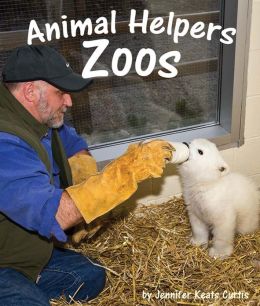 |
Animal Helpers: Zoos By: Jennifer Keats Curtis I recommend this little book about how zoos serve as a means to protect and conserve various species of animals–especially those who are endangered and threatened. Animal Helpers: Zoos would work well as an introduction to this topic to spin off students” research projects and to stimulate their interest in learning more. It could be used as reading material in a center with various activities related to the topic to complete individually or with a partner, or as a read-aloud book during science class. If you are planning a field trip to a zoo, read this book before you go to teach your students what goes on behind the scenes! If you are a 3rd, 4th, or 5th grade teacher, principal, or school librarian, this is definitely a book to order, especially since it is aligned with 3rd and 5th grade Common Core and the Science Frameworks. This book is presented well–the clearly written text includes new vocabulary and concepts that are paired with clear and inviting photographs. I especially liked the way the photos of the animals (many of them cute babies!) illustrated the different jobs of the zookeeper, such as feeding the baby animals a bottle, scrubbing a rhino”s foot, and engaging the animals in playful activities to keep them from getting bored. Especially noteworthy is the educational section at the back of the book that contains thought-provoking activities, websites, and more detailed information about wildlife conservation, as well as additional vocabulary that includes the fields of animal study such as herpetology, ornithology, and entomology. Teachers will appreciate the corresponding publisher”s website that shows the alignment with CCSS, NGSS, and Social Studies Standards, 51 pages of enriching teaching activities, and information about the author. This website contains downloadable e-books with additional features such as audio. Grades K-2. 2013, Sylvan Dell, Ages 5 to 8, $17.95. REVIEWER: Debby Chessin (National Science Teachers Association (NSTA)). ISBN: 9781607187134 |
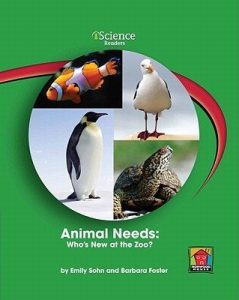 |
Animal Needs: Who’s New at the Zoo? By: Emily Sohn This 24-page primary science book introduces basic information about what animals need to live and be healthy. Readers are told that there is a new exhibit at the zoo. They are then presented with information about animals that will help them decide which animal will be living in the exhibit. The authors of this series use a problem-based learning scenario and questioning techniques that encourage science inquiry. This volume includes an iScience Puzzle with an explanation of how to solve it, a discover activity, a “science at work” section, connections to history, a glossary, sources for further reading, and additional notes. The illustrations are photographs. This is a high-quality, durable book–perfect for the classroom. I highly recommend this book to teachers of students in grades K to 3. Upper-grade teachers with special education students as well as teachers using differentiated instruction will also find this book to be very useful. 2011, Norwood House, Ages 5 to 8, $15.95. REVIEWER: Lois Spangler (National Science Teachers Association (NSTA)). ISBN: 9781599534046 |
 |
Belly Up By: Stuart Gibbs Something is rotten in FunJungle, the huge Texas park that’s a cross between Disneyland and the San Diego Zoo, and it’s up to twelve-year-old Teddy, the son of the park’s primate specialist, to figure out what it is. The problem starts with the death of Henry, the foul-tempered hippo who’s the park’s mascot, and who turns out to have been deliberately killed. Teaming up with Summer, the daughter of the park’s owner, Teddy investigates the crime and stumbles into what looks like a conspiracy but can he solve it before Henry’s killers come after him? Promotional copy connects Gibbs to Carl Hiaasen, and there’s definitely something of Hiaasen’s easygoing, direct style and ecology-related theme here. Even more than Hiaasen’s work, though, this is steeped in old-fashioned adventure, starring a kid with enviable freedom and opportunity, who’s tangling with classic crime (smuggling of emeralds!) and who’s backed by two strong, protective parents. The setting is key, and Gibbs draws a vivid picture of FunJungle, a kajillionaire’s pet project that’s torn between gate-turning revenue and animal-preservation respectability. Teddy’s free-range access to myriad animal enclosures is an alluring fantasy, which the book firmly supports with clear-eyed information about animal behavior and zookeeping logistics. Touches of humor provide additional enjoyment, with many readers likely to find the high and low point simultaneously in the high-speed splatter of a long-rotting hippo carcass. Smart, unironic, and confidently bereft of cool, this is a solidly enjoyable action mystery, a useful complement to Anderson’s satirical Thrilling Tales titles (Whales on Stilts, BCCB 4/05, etc.) Review Code: R — Recommended. 2010, Simon, Ages 9 to 12, $15.99. REVIEWER: Deborah Stevenson (The Bulletin of the Center for Children’s Books). ISBN: 9781416987314 |
 |
Don’t Feed the Boy By: Irene Latham Illustrated by: Stephanie Graegin Eleven-year-old Whit Whitaker has been raised in the zoo where his parents work, with only the zoo workers, the animals, and his homeschool teacher as companions. Increasingly frustrated by his lack of social opportunities and his parents’ seeming lack of interest in him, Whit is thrilled to make friends with Stella, a girl his age who comes to the zoo every day to draw the birds. When Whit sneaks off to accompany Stella to her home, however, he learns that there are worse homes than the zoo: Stella’s dad, disabled by a truck accident years ago, is addicted to pain pills, is verbally abusive, and has a gun, which he used to wound Stella’s brother, who has since run away. Stella wants to run away, too, and she has a place in mind the zoo and Whit must decide whether or not to help her hide even as he figures out how to confront his own parents about his desire for a life beyond the bounds of the zoo’s fence. The intriguing premise of a kid raised in a zoo will appeal tremendously to animal-loving kids, and Latham provides lots of fascinating zoo specifics without disrupting the narrative flow. The story is credibly grounded, and Whit’s moral dilemma concerning Stella is compelling. the soft shading and simplified figures in Graegin’s occasional black and white illustrations are somewhat more warm and cozy than the story itself, but they’re attractive decorations. Kids who wish they could live at the zoo will find this a satisfying read. Review Code: R — Recommended. (c) 2012, Roaring Brook, Ages 9 to 12, $15.99. REVIEWER: Jeannette Hulick (The Bulletin of the Center for Children’s Books). ISBN: 9781596437555 |
 |
Felicity Floo Visits the Zoo By: E. S. Redmond This cleverly illustrated book teaches, without lecturing, how colds and flu are spread. It does not mention germs or viruses; the illustrations do the teaching. All the animals in the zoo are sick. The zoo keeper does not know how this has happened, but the reader is told the story. A girl named Felicity Floo has a runny nose when she comes to the zoo. She wipes her nose without a tissue, and it leaves her hand covered with green, gloppy goo. She visits all the animals and leaves her sticky green hand prints on everything she touches. A large number of zoo animals are named and pictured, each with green handprints on them. Felicity’s green handprints are everywhere, but she does not know that she is causing a problem. The author suggests that the reader might want to go bowling instead of to the zoo. However, Felicity’s green handprints are also on the bowling ball. This playful book with a serious message is written in rhyme with only a few lines of text on each page. It could serve as a lead-in to a discussion about using tissues and washing hands. Fiction, Highly Recommended. 2009, Candlewick, Ages 2 to 8, $15.99. REVIEWER: Betty Key (The Lorgnette – Heart of Texas Reviews). ISBN: 9780763634445 |
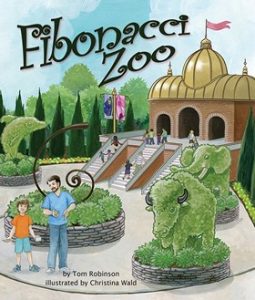 |
Fibonacci Zoo By: Tom Robinson Illustrated by: Christina Wald Fibonacci Zoo” is an unusual zoo picture book that effortlessly introduces the math concept of number patterns in sequences. The Fibonacci Zoo illustrates the Fibonacci sequence, which begins with the number 1, then continues with each number following being the sum of the two previous numbers. Thus, when Eli makes notes of his visit to the Fibonacci Zoo, he finds the exhibits consist of…. 1 alligator, 1 bison, 2 camels, 3 dolphins, 5 elephants, 8 flamingos, 13 gorillas, 21 hippos… and one more exhibit of possibly chameleons that had how many chameleons? (The reader is invited to guess what 13 + 21 = in chameleons, to complete the Fibonacci sequence). Like other Arbordale teaching books, “Fibonacci Zoo” ends with four additional pages of creative learning games, including Number Patterns, Fibonacci Numbers in Nature, Golden Spiral, and Animal Matching, plus intriguing sidebars of information titled Fibonacci and you. Joyous colored illustrations make the fantastic Fibonacci Zoo a reality for kids to bounce through, making learning about math fun and easy, for grades K-3. The Math Shelf …., Arbordale Publishing, $17.95. grades K-3 (PUBLISHER: Arbordale Publishing (Mount Pleasant SC:), PUBLISHED: [2015].) REVIEWER: Midwest Book Review ISBN: 9781628555530 |
 |
In the Forests of the Night By: Kersten Hamilton Following immediately after Tyger, Tyger (Clarion, 2010/VOYA December 2010), Teagan attempts to establish normalcy in her life after her return from Mag Mell. Her boyfriend, Finn, warns that there will be no safety as long as Fear Doirich rules Mag Mell and continues to try to lure Tea back. Cat Sidhe lurk at every corner, even though Raynor, Finn’s guardian angel, guards the entrance to Mag Mell against further intrusion. When Fear’s agents target Tea’s friends and family, she goes on the offensive. Carrying an iron knife into Mag Mell to kill Fear, Tea finds she has unwittingly fallen in with Queen Mab’s plans. Tea escapes without murdering the man who threatens her family, only to declare war, not only on Fear but also on Mab herself. An emphasis on Celtic mythology sets this series apart. Unique characters, strong plot, and nonstop action will hook teens and reel them in. Tea’s fey, artistic mother, who dies in Tyger, Tyger; her father, a lovable, absent-minded librarian; and Aiden, her naive little brother inspire Tea to be fiercely protective. She is willing to sacrifice herself to save her family. The book abounds with wonderful characters. Even minor ones are well developed and memorable: Abby, Tea’s best friend, whose mob ties prove indispensable, and Mrs. Santini, who believes a good meal can solve anything. Finn Mac Cumhail, Tea’s dark mysterious “cousin,” provides a deliciously intense love interest. This strong new fantasy series will attract a solid fan base. VOYA CODES: 4Q 4P S (Better than most, marred only by occasional lapses; Broad general YA appeal; Senior High, defined as grades 10 to 12). 2011, Clarion/Houghton Mifflin Harcourt, Ages 15 to 18, $16.99. REVIEWER: Nancy Wallace (VOYA). ISBN: 9780547435602 |
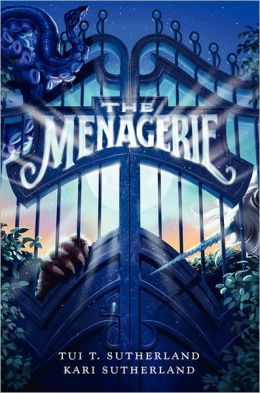 |
The Menagerie By: Tui T. Sutherland and Kari Sutherland There’s something unusual about Logan Wilde, and it’s not just that he is a newcomer to the small town of Xanadu. He has a way with animals, from his pet fish to his mice, his cat to the griffin that has hidden itself under his bed yes, that’s right: griffin. There’s something usual about Xanadu too, specifically The Menagerie on the outskirts of town. No one outside of the property’s inhabitants is supposed to know about the unusual collection of magical and mythical creatures that abides there, but when five griffin cubs escape and one chooses to hide under Logan’s bed, he is drawn into the mysterious place. Along with classmates Zoe Kahn and Blue (Menagerie inhabitants), Logan quickly becomes engaged in tracking down cubs, and figuring out how they escaped. When the trio come to realize that Logan’s missing mother has had a long career with the Menagerie, and that the perimeter of the compound was deliberately sabotaged, they realize there’s more at stake then getting a few cubs back home undetected. Readers will enjoy this satisfying introduction to an intriguing setting and community, but they may be less pleased with the novel’s clumsy and abrupt “To be continued ” ending. 2013, Harper/HarperCollins Publishers, Ages 8 up, $16.99. REVIEWER: Heidi Hauser Green (Children’s Literature). ISBN: 9780060780647 |
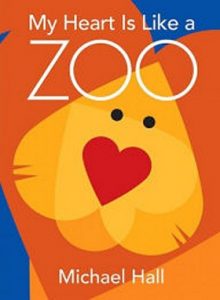 |
My Heart is Like a Zoo By: Michael Hall In his first book, Hall, a graphic designer, takes the idea of love being a many-splendored thing and runs with it straight to the animal kingdom. Using a heart shape as his core visual element, he creates a 20-member menagerie to illustrate the various facets of his affection: “My heart is like a zoo-/ eager as a beaver,/ steady as a yak,/ hopeful as a hungry heron fishing for a snack.” Not every poetic conceit works-there’s a jarring quality to having one’s heart described as “crafty as a fox” or “snappy as a crab”-and more sophisticated eyes may feel Hall could have used more variation in crafting his animals (the heart shape is used mostly as a head and some form of appendage). But children just learning about shapes will revel in these pages, thanks to Hall’s masterful blending of bright, saturated colors, his posterlike compositions, and the sheer animal magnetism of the species he’s chosen. Teachers will also find fodder for classroom activities when February rolls around. 2010, Greenwillow Books/HarperCollins, Up to age 5, $16.99. REVIEWER: Publishers Weekly (Publishers Weekly). ISBN: 9780061915109 |
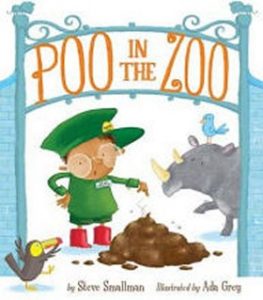 |
Poo in the Zoo By: Steve Smallman Illustrated by: Ada Grey Zookeeper Bob McGrew cares for lots of animals, which also means lots of poop-scooping, including gobs of gnu poo, bouncy kangaroo poo, / a dotted line of droppings from a fat wombat! But his routine is interrupted when an iguana escapes its habitat and goes on an eating binge, devouring cakes, pizza, and more (even fireflies, for something light ). Then Bob notices the iguana s subsequent poo is, unbelievably, glowing and he decides it must be from outer space. Word of the luminous leavings spreads, and they become a major attraction, eventually drawing interest from an enthusiastic poo-collector who buys the dung for his poo museum, enabling Bob to purchase a much-appreciated robotic poop-scooper. Colorful, cartoonish illustrations depict the zoo setting and humorously expressive animals with playful details, while the narrative s rhythm and rhymes keep things peppy. The scatological scenarios are certainly copious, though blatantly hyperbolic, including the museum s seemingly endless array of apothecary jars with labeled specimens, featured on the endpapers. The title alone will be enough to get this chuckleworthy book in the right hands. Grades K-2. REVIEWER: Shelle Rosenfeld ISBN: 9781589251977 |
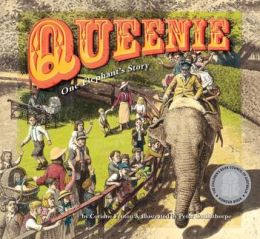 |
Queenie: One Elephant’s Story By: Corinne Fenton Illustrated by: Peter Gouldthorpe Queenie thrived at the Melbourne Zoo for forty-four years until her death in 1945. Achieving a lovely sense of time and place, Australian author Fenton and illustrator Gouldthorpe bring her poignant story to young readers. Baby Queenie’s capture by hunters awakens memories of little Babar, but her life was far from fantasy and her captivity bordered on exploitation. After enduring a frightening journey from India to Melbourne, she settled at the zoo and aged enough to be ridden. Every day except Mondays, Queenie carried in her howdah about five hundred passengers, who came especially for the ride around the zoo. Gentle Queenie soon became a star, adored by children who left her apples and peanuts, but teased by others less kind–young listeners will applaud as Queenie gets her revenge on some nasty boys by spraying them with dirty water. A highlight of her reign was a flower-crowned appearance (unfazed by floats or noisy bands) in Melbourne’s 1934 Floral Parade. Abruptly, one evening in 1944, a terrible accident happened: Queenie somehow crushed her keeper. No one knows how it came about, but a coroner pronounced Queenie dangerous and the high cost of food in wartime provided an excuse for putting her to sleep. The heartbreak of her death is quickly followed by a turn of the page where a spread shows happy elephants in a modern zoo’s spacious jungle environment. Will that be enough to ease small readers’ pain? Gouldthorpe’s illustrations of Queenie and other animals extend beyond the softened colors into borders of unpainted sketching, while human clothing evokes the teens, twenties, and thirties–even the endpapers are colored a nostalgic retro green. This moving true story could inspire thoughtful discussion of the relationship between humans and animals and evolving zoo philosophy. 2013 (orig. 2006), Candlewick, Ages 7 up, $16.99. REVIEWER: Barbara L. Talcroft (Children’s Literature). ISBN: 9780763663759 |
 |
Saving the Baghdad Zoo: A True Story of Hope and Heroes By: Kelly Milner Halls and William Sumner Major Sumner, a civil affairs officer, was called to Iraq in 2003. He had trained as an archaeologist and was going to work closely with the Iraqis in resurrecting a suppressed heritage, but one particular commander had something different in mind. He asked Major Sumner to look at a small local zoo that, in fact, turned out to be one of the largest in the Middle East. Tigers, lions, hyenas, and several other species were on the verge of death, thanks to the effects of war and looting. Some cages were empty; many other animals had succumbed to starvation. The soldiers making up the 3rd Infantry Division attempted to care for these creatures to the best of their abilities, but the animals desperately needed medical attention and food. This narrative provides an amazing account of the selfless acts committed by a group of dedicated soldiers, doctors, and volunteers. Readers will be fascinated with the story of Saedia, a thirty-two-year-old brown bear, whose blindness prevented her from escaping the unspeakable conditions, and Lumpy, a one-humped camel who was suffering from starvation and dehydration. The heroic acts of these people offer hope in the midst of death and destruction. The photographs not only capture the real-life horror of the animals and their dismal environment, but they also portray the peace that later surrounded each one. This book would complement the elementary social studies, animal and language arts units. It is truly a worthwhile read. 2010, Greenwillow Books/HarperCollins, Ages 8 to 12, $17.99. REVIEWER: Summer Whiting (Children’s Literature). ISBN: 9780061772023 |
 |
The Secret Zoo By: Bryan Chick Chick debuts with an action-packed and breathless story about teamwork, first published in 2007 by the author’s Second Wish Press. When Noah’s sister, Megan, disappears, he and his friends Ella and Richie come across Megan’s notes and journal entries, which lead them to the Clarksville City Zoo. When the trio is separated, the action intensifies as readers follow their separate paths through the zoo’s exhibits, which disguise a secret land in which animals and humans coexist blissfully (“They’d entered a city that seemed to have been built by the most potent pieces of a hundred imaginations)”. With the help of new friends that include Podgy the penguin and Blizzard the polar bear, the group tunnels through this maze, encountering some less-friendly creatures and shifty security guards who insist that “the fate of the world depended on keeping the secrets of the zoo safe.” While the writing is not as complex or magical as the premise, the story should appeal both to animal-lovers and a broader audience. While many threads are resolved, Chick lays the groundwork for later books. Greenwillow Books/HarperCollins, Ages 9 to12. 2010, $16.99. REVIEWER: Publishers Weekly (Publishers Weekly). ISBN: 9780061987502 |
 |
A Sick Day for Amos McGee By: Philip Christian Stead Illustrated by: Erin E. Stead Beyond his usual work as zookeeper, Amos McGee always finds time for his animal friends: playing chess with the elephant, racing with a turtle, sitting quietly with a shy penguin, wiping the rhino’s runny nose, and reading to the owl. One day, waking with a bad cold, he decides to stay home. His animal friends await him in vain and wonder. Later they gather, ride the bus, and, bearing a red balloon, delight Amos with a visit. As they play together, Amos feels well enough to get up and share a pot of tea. Remembering that they all must catch an early bus the next morning, they bed down peacefully for the night. The story is told simply but in rich detail and with the sly humor of the imaginative premise. It is visualized in woodblock prints and gentle pencil drawings with subtle occasional touches of transparent colors. Added details include the penguin’s red socks, a tiny, sign-carrying mouse, and a small monkey up a tree. The naturalistic animals and keeper dominate the double-page scenes with a few props like an old-fashioned brass bed and stove. Observing the group having tea in china cups is a delight. 2010, A Neal Porter Book/Roaring Brook Press, Ages 3 to 6, $16.99. REVIEWER: Ken Marantz and Sylvia Marantz (Children’s Literature). ISBN: 9781596434028 |
 |
Stop Snoring, Bernard! By: Zachariah OHora Poor Bernard. What’s a snoring otter to do? His family and otter friends complain that they can’t sleep a wink when Bernard starts to snore. When Grumpy Giles orders Bernard to snore elsewhere, he tries to sleep with the alligators, but they yell at him too. Nor does sleeping in the fountain work; the giraffes yell at him there, as do the elephants when the otter tries sleeping in a puddle. Sad and lonely Bernard settles for a hidden place to nap and falls happily asleep, not hearing his otter friends calling for him. When the little otter wakes up in the morning, he discovers he’s slept in a bat cave. Well, since bats fly at night and sleep during the day, Bernard’s snoring doesn’t bother them at all, but they tell him not to snore during the day. Again Bernard is sad. Isn’t there someplace he can sleep without bothering somebody else? Just as he’s about to leave the zoo, the other otter’s find him and tell him to come home–they sleep even less when he isn’t with them. A sweet story for beginning readers and their younger siblings, although I would have preferred a little more definition in the illustrations. 2011, Henry Holt and Company/Macmillan, Ages 4 to 8, $16.99. REVIEWER: Sarah Maury Swan (Children’s Literature). ISBN: 9780805090024 |
 |
There is No Dog By: Meg Rosoff When a sweet, lonely, twenty-one-year-old zoo worker named Lucy sends a small prayer to God asking to fall in love, God gets the memo and, being a rather feckless teenage boy named Bob, decides he will fulfill the prayer himself. This, as his assistant Mr. B knows from experience, can only lead to global meteorological upheaval of, ahem, biblical proportions. Bob has a gift for creative invention and the book excels at conveying the simultaneous wonder and absurdity of the world but he’s also a bit of a sociopath when it comes to recognizing human suffering. Thousands dead of drought? Why should that be his problem when he’s overwhelmed by unrequited lust? His single-minded focus on Lucy both flatters and unnerves her (but he’s gorgeous, so she goes with the former impulse at first), and if she is a bit flat as a love interest, it is because the novel as a whole is more interested in allegory, image, and commentary than in character. The narrative threads and multitude of bit characters come together like puzzle pieces, offering thought-provoking world-building at an emotional remove. For all the flippancy of the setup, Rosoff conveys some genuine spiritual reflection in the character of Mr. B, who, as Bob has sent the planet into chaos over the millennia, has “struggled day after day to make things better, to answer a few prayers, right a few wrongs, who has suffered along with his planet and tried to fix things, in however small a manner.” Readers interested in the powerful-being-falls-madly-for-ordinary-girl angle will be better off with Greek mythology, but those with a fondness for satire or religious inquiry will be fascinated. Review Code: R — Recommended. (c) Copyright 2012, Putnam, Grades 10 up, $17.99. REVIEWER: Claire Gross (The Bulletin of the Center for Children’s Books). ISBN: 9780399257643 |
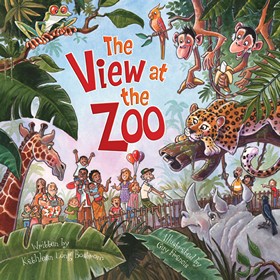 |
The View at the Zoo By: Kathleen Long Bostrom Illustrated by: Guy Francis The mustachioed zookeeper is just one of the beasts in this gorgeous trip to the zoo. He makes his morning rounds, trundling along with the food cart that’s brimming with tasty morsels for the still-groggy animals’ breakfasts. He also offers up morning suggestions. To the yawning lion, mane all crinkly, the zookeeper insists, “Mr. Lion, comb that hair.” To the giraffes, whose necks are still crooked from sleep, he suggests, “…please, stand up straight! / That’s more like it—you look great!” Then the gates open, and the visitors stream in. The rhyming couplets stroll through the zoo, dropping by all the attractions from the safari animals to the reptiles, peering in fascination at the things the creatures do—the eating, the prancing, the preening. But, wait, who’s watching whom? This perspective-shifting tale is lavishly decorated with quirky cartoon illustrations, bright and rich with warmth and humor. The exotic birds burst from the page in brilliant color, and the expressive elephant is rendered in pinkish gray that embodies tenderness. Bostrom enthusiastically explores the links between all the world’s creatures, celebrating both diversity and similarities. Like the zoo, this happy romp will be often revisited. 2011, Ideals, 32 pp., $14.99. Category: Picture book. Ages 2 to 8. © 2011 Kirkus Reviews/VNU eMedia, Inc. All rights reserved. REVIEWER: Kirkus (Kirkus) ISBN: 9780824956691 |
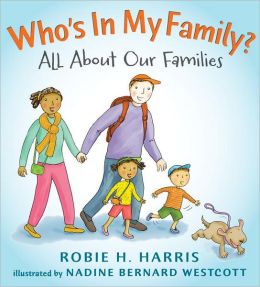 |
Who’s In My Family?: All About Our Families By: Robie H. Harris Illustrated by: Nadine Bernard Westcott The author of the kids’ body book, “Who Has What?” returns to explore the meaning of family in her latest book. Our lead family, an interracial unit of four people plus their dog, begin their exploration of neighborhood families with breakfast. The breakfast food choices at the different family tables range from eggs to shrimp dumplings to burritos. A very thorough presentation of different kinds of families and their similarities and differences are presented over the next twenty-four pages. From hair color to skin color to gender, all kinds of families are presented, even including a polar bear family at the zoo. Digitally created illustrations are bright and colorful and chock full of details worth further exploration. Harris presents a fully updated and comprehensive look at modern families in a child friendly format. This book is a worthy purchase for all library and home collections. 2012, Candlewick, Ages 4 to 8, $15.99. REVIEWER: Sharon Oliver (Children’s Literature). ISBN: 9780763636319 |
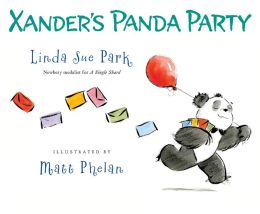 |
Xander’s Panda Party By: Linda Sue Park Illustrated by: Matt Phelan Phelan (Around the World) takes Park’s jaunty story about a panda with a complicated social life and develops it still further. In ink-and-watercolor vignettes, he animates the many zoo creatures Xander considers inviting to his party, capturing their expressions and interactions with a few quick pen strokes. Xander begins with his bear compatriots: Black Bear, Brown Bear, the Polar Bears, and Koala. “From her tree, Koala hollered,/ ‘Xander, I am not a bear…. Will I not be welcome there?’ ” Xander reconsiders: should he include all mammals? When he does, Rhinoceros complains that he can’t bring his bird. Should he include birds, too? Eventually, of course, Xander must invite everyone, and after the arrival of an unexpected mystery guest, the attendance list expands-providing Xander with a new friend. Park (The Third Gift) is really talking about the fluidity of boundaries, and how social groupings that look solid fall apart under closer inspection. Her afterword explores symbiosis (the rhino-bird duo), taxonomic classification, and zoo exchanges-there’s food for thought throughout. 2013, Clarion, Ages 4-8, $16.99. REVIEWER: Publishers Weekly (Publishers Weekly). ISBN: 9780547558653 |
 |
Zoobreak By: Gordon Korman Poor Luthor, Savannah Drysdale’s pet Doberman, is absolutely devastated missing his best friend, Cleopatra, a capuchin monkey who has been missing for weeks. Griffin Bing, Savannah’s school teacher has scheduled a class trip to a floating zoo where Savannah discovers Cleo and the harsh, dirty, unhealthy atmosphere of the zoo. Knowing that Cleo has been stolen, Savannah and her friends are so appalled by the conditions of the floating zoo they plan to rescue not only Cleo but the entire lot of animals. This is a wonderful, unique story that is tension-filled from the very beginning and does not let up. With the help of Savannah’s friends, one with a sleep disorder, one who claims to be “The Man With A Plan,” and a wonderful assortment of adult characters, this story pulls the reader in right from the start. The idea is clever, and Savannah is portrayed as Cedarville’s greatest authority on animals. There is a lot of information woven throughout the story that kids will find interesting as well. Riveting, humorous and well told, this book is a great read for kids. 2009, Scholastic, Ages 9 to 12, $16.99. REVIEWER: Joan Elste (Children’s Literature). ISBN: 9780545124997 |
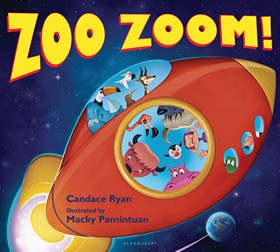 |
Zoo zoom! By: Candace Ryan Illustrated by: Macky Pamintuan Normal 0 Ryan s latest children s book is a zany aerospace adventure.Zoo animals spy a spaceship and decide to take a trip to the moon. The animalshave specific jobs to perform if their mission is to succeed. But soon afterliftoff, the rhino dozes off at the controls, and the animals have to scramble toturn the ship around. Ryan s tight mix of wordplay and rhyming onomatopoeia isset to a predictable yet playful pattern for children to easily grasp. Uniqueto her clever narrative is Ryan s choice of animal names that segue smoothlyinto distinctive jobs. Good examples are lines such as monkey turns thekey and buffalo shifts low. Perfectly complementing Ryan stext is Pamintuan s colorful and comical scenes many of which are two-pagedisplays. While younger preschoolers will be captivated with the combination ofrhyming wordplay and hilarious illustrations, older readers may be moreinquisitive and find all the matching rhymes. Designed to be interactive, ZooZoom! is a great addition for home and library collections, particularly as a read-aloud selection. REVIEWER: Anita Lock ISBN: 9781619633575 |
|
Updated 04/04/2019 To stay up to date on new books on this topic, consider subscribing to The Children’s Literature Comprehensive Database. For your free trial, click here. If you’re interested in reviewing children’s and young adult books, then send a resume and writing sample to info@childrenslit.com. |



